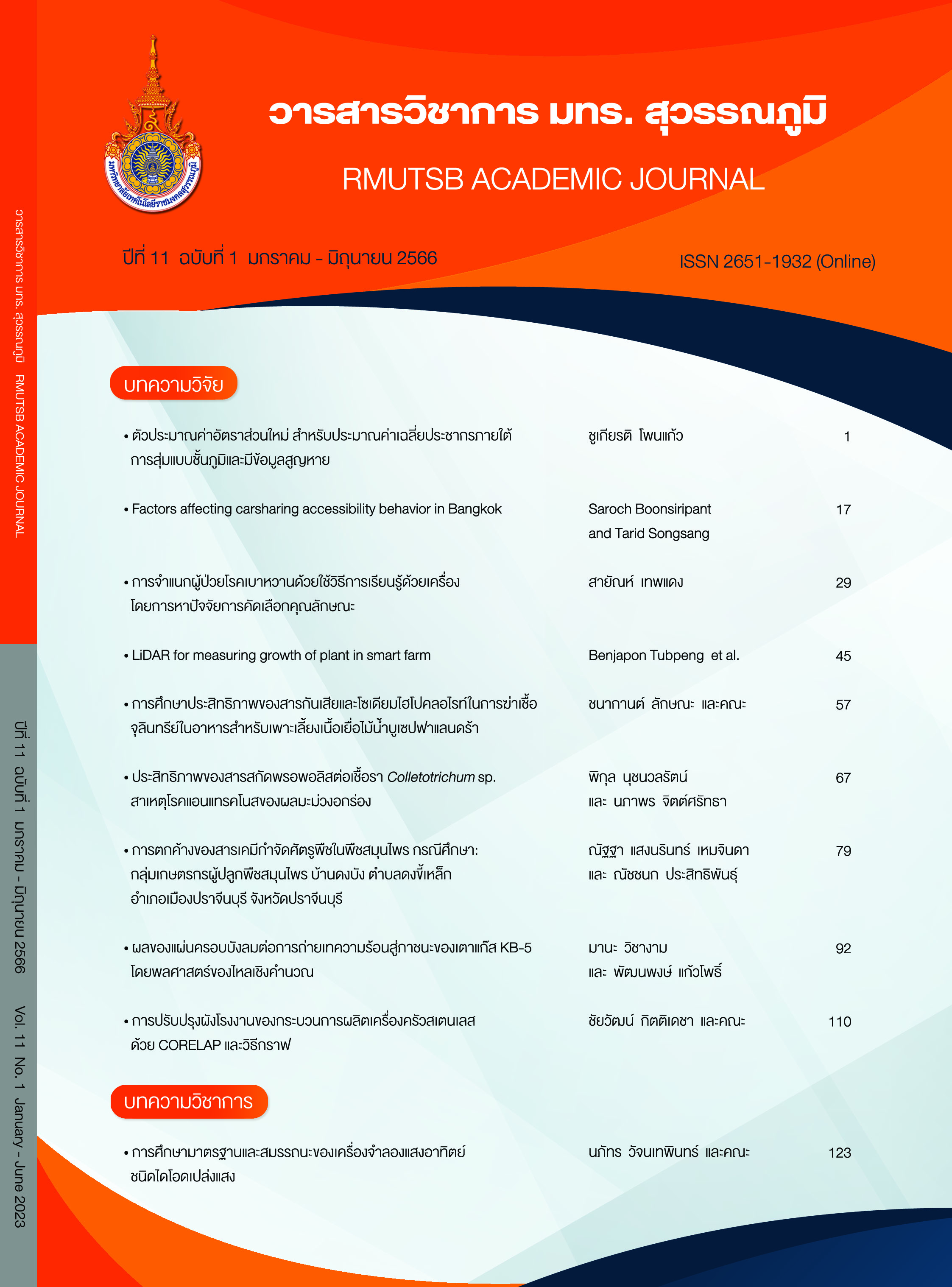LiDAR for measuring growth of plant in smart farm
Main Article Content
Abstract
Despite being of great importance to the economy and society of Thailand, the agricultural sector is unable to generate as much income as it should. The low average growth rate of agricultural production per labor is the main problem. Due to traditional farming practices, the resulting yields are only as effective as they should be, as it cannot compete with countries that are able to effectively apply digital technology and innovation. This study aims to address this issue by utilizing LiDAR (Light Detection and Ranging) technology and machine learning which used for predicting the accuracy of plant stage prediction to monitor the height and color of plants at three stages, consisting of stage 1 for plants aged 0-7 days, stage 2 for plants aged 7-14 days, and stage 3 for plants aged 15-45 days to accurately determine their harvesting stage. This concept was demonstrated using LiDAR measurements of lettuces that is Green Cos. Point clouds were generated from 3D RGB images and depth information from LiDAR camera (Intel RealSense L515) at three stages of the plant. For machine learning, feature extraction and model training and evaluation were used. Results showed height feature prediction is 80% accuracy, RGB image feature prediction was 100% and height with RGB image feature prediction was 90%. This can be further applied to real-world use in smart farming in the future.
Article Details

This work is licensed under a Creative Commons Attribution-NonCommercial-NoDerivatives 4.0 International License.
Published manuscript are the rights of their original owners and RMUTSB Academic Journal. The manuscript content belongs to the authors' idea, it is not the opinion of the journal's committee and not the responsibility of Rajamangala University of Technology Suvarnabhumi
References
Andújar, D., Escolà, A., Dorado, J., & Fernández-Quintanilla, C. (2011). Weed discrimination using ultrasonic sensors. Weed Res, 51, 543-547.
Andújar, D., Escolà, A., Rosell-Polo J. R., Fernández-Quintanilla, C., & Dorado, J. (2013). Potential of a terrestrial LiDAR-based system to characterise weed vegetation in maize crops. Computers and Electronics in Agriculture, 92, 11-15.
Andújar, D., Rueda-Ayala, V., Morono, H., Rosell-polo, J., Escol`a, A., Valero, C., Gerhards, R., Fernández- Quintanilla, C., Dorado, J., & Griepentrog, H. (2013). Discriminating crop, weeds and soil surface with a terrestrial LIDAR sensor. Sensor, 13(11), 14662-14675.
Butploy, N., & Boonying, S. (2020). Classification of Benjapakee Buddha amulets image by deep learning. RMUTSB Academic Journal, 8(1), 101-111.
Duangnirat, B. (2019). Agriculture: Alternative way of survival. Retrieved 20 December 2020, from https://www.depa.or.th/th/article-view/agriculture-alternative-way-of-survival.html.
Herrero-Huerta, M., Bucksch, A., Puttonen, E., & Rainey, K. M. (2020). Canopy roughness: A new phenotypic trait to estimate aboveground biomass from unmanned aerial system. Plant Phenomics, 2020, 6735967.
Polo, J. R. R., Sanz, R., Llorens, J., Arnó, J., Escolà, A., Ribes-Dasi, M., Masip, J., Camp, F., Gràcia, F., & Solanelles, F. (2009). A tractor-mounted scanning LIDAR for the non-destructive measurement of vegetative volume and surface area of tree-row plantations: A comparison with conventional destructive measurements. Biosystems Engineering, 102(2), 128-134.
Saha, K. K., Tsoulias, N., Weltzien, C., & Zude-sasse, M. (2022). Estimation of vegetative growth in strawberry plants using mobile LiDAR laser scanner. Horticulture, 8(2), 90.
Soudarissanane, S., Lindenbergh, R., Menenti, M., & Teunissen, P. (2011). Scanning geometry: Influencing factor on the quality of terrestrial laser scanning points. ISPRS Journal of Photogrammetry and Remote Sensing, 66(4), 389-399.
Tsoulias, N., Paraforos, D. S., Fountas, S., & Zude-Sasse, M. (2019). Estimating canopy parameters based on the stem position in apple trees using a 2D LiDAR. Agronomy, 9, 740.
Weiss, U., Biber, P., Laible, S., Bohlmann, K., & Zell, A. (2010). Plant species classification using 3D LIDAR sensor and machine learning in plant classification. IEEE Computer society, Proceeding of The Ninth International Conference on Machine Learning and Applications (pp. 339-345). Washington DC: IEEE Computer Society.


